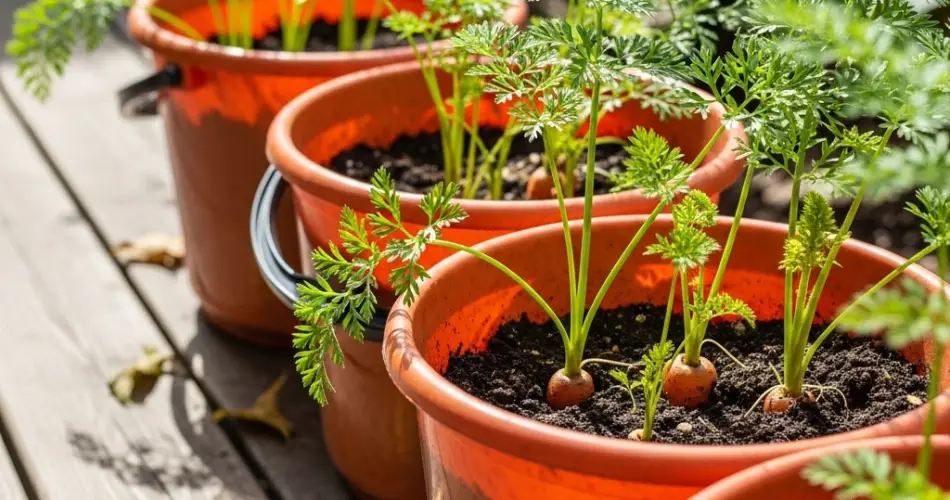Carrots are a popular root vegetable that can thrive in containers with the right soil and care. Their crisp texture and sweet flavor make them a favorite in home gardens, and growing them in pots or buckets is an excellent option for those with limited space. Unlike many other vegetables, carrots need loose, well-draining soil to grow straight, healthy roots. This guide explores how to create the best soil mix for container-grown carrots and tips for ensuring a successful harvest.
Choosing the Right Container
Carrots require containers that are deep enough to accommodate their roots. A minimum depth of 12 inches is recommended, while larger varieties may need 14 to 16 inches. Wide containers allow multiple carrots to grow simultaneously. Ensure that containers have drainage holes to prevent waterlogging, which can cause root rot and poor development. Buckets, pots, or even repurposed wooden boxes work well if they meet these requirements.
Understanding Carrot Soil Needs
The key to growing healthy carrots in containers is loose, well-draining soil. Dense, heavy soils can stunt root growth or cause forked and misshapen carrots. Ideally, the soil should be light and crumbly, with good aeration to allow roots to expand freely. Avoid using garden soil alone if it is heavy or clay-rich, as it can compact and restrict root development.
Creating the Ideal Soil Mix
A high-quality soil mix for container-grown carrots typically combines several components to provide nutrients, drainage, and structure. Here’s a reliable mix:
-
Loamy Soil or Potting Mix: Provides structure and retains moisture while allowing roots to grow freely.
-
Compost: Adds essential nutrients for healthy growth. Use well-decomposed compost to avoid introducing pathogens or weed seeds.
-
Sand or Perlite: Improves drainage and prevents soil compaction, helping roots grow straight and smooth.
-
Optional Organic Fertilizer: A balanced organic fertilizer can be incorporated at planting to give young carrots a nutrient boost.
A common ratio is 2 parts loamy soil or potting mix, 1 part compost, and 1 part sand or perlite. This combination ensures moisture retention without waterlogging, while maintaining loose texture for root expansion.
Preparing the Container
Before planting, fill your container with the soil mix, leaving about an inch of space from the rim. Mix thoroughly to ensure even distribution of compost and sand. Lightly moisten the soil before sowing seeds, as this helps improve germination. Smooth the surface to create an even planting bed.
Planting Carrot Seeds
Carrot seeds are small and delicate, so they should be sown shallowly. Plant seeds about a quarter-inch deep and space them 1 to 2 inches apart. For larger varieties, provide slightly more spacing to prevent overcrowding. After sowing, cover lightly with soil and water gently to settle the seeds. Keep the soil consistently moist until seedlings emerge.
Sunlight and Placement
Carrots need full sunlight for optimal growth. Place your containers in a location that receives at least 6 hours of direct sunlight each day. While carrots can tolerate partial shade, insufficient sunlight may slow growth and reduce root sweetness. Adequate sunlight is essential for strong, healthy roots.
Watering and Maintenance
Container-grown carrots require consistent moisture to prevent the roots from becoming tough or splitting. Water gently and regularly, keeping the soil evenly moist. Mulching with straw or shredded leaves can help retain moisture and prevent surface crusting. Avoid overwatering, as soggy soil can lead to root rot.
Thinning Seedlings
Once seedlings develop a few true leaves, thin them to avoid overcrowding. Crowded carrots tend to develop small or misshapen roots. Carefully snip extra seedlings at the soil level instead of pulling them to avoid disturbing nearby roots. Proper spacing allows each carrot to grow straight and reach its full size.
Pests and Disease Prevention
Carrots are relatively hardy, but container gardens can attract pests such as aphids, carrot flies, and root maggots. Inspect plants regularly and remove affected leaves or insects. Use floating row covers to prevent infestations, and ensure good air circulation around containers to minimize fungal issues.
Harvesting Carrots
Carrots are typically ready for harvest 60 to 80 days after sowing, depending on the variety. Pull them gently from the soil once they reach the expected size. Harvesting at the right time ensures sweet, tender roots. Leaving carrots too long in the soil can make them woody or bitter.
Final Tips
Growing carrots in containers is rewarding and feasible even in limited spaces. Using the right soil mix, providing consistent moisture, sunlight, and proper spacing are key factors in producing healthy, straight roots. With careful attention to soil preparation and plant care, container-grown carrots can yield a bountiful harvest, perfect for salads, cooking, or snacking straight from your garden.



